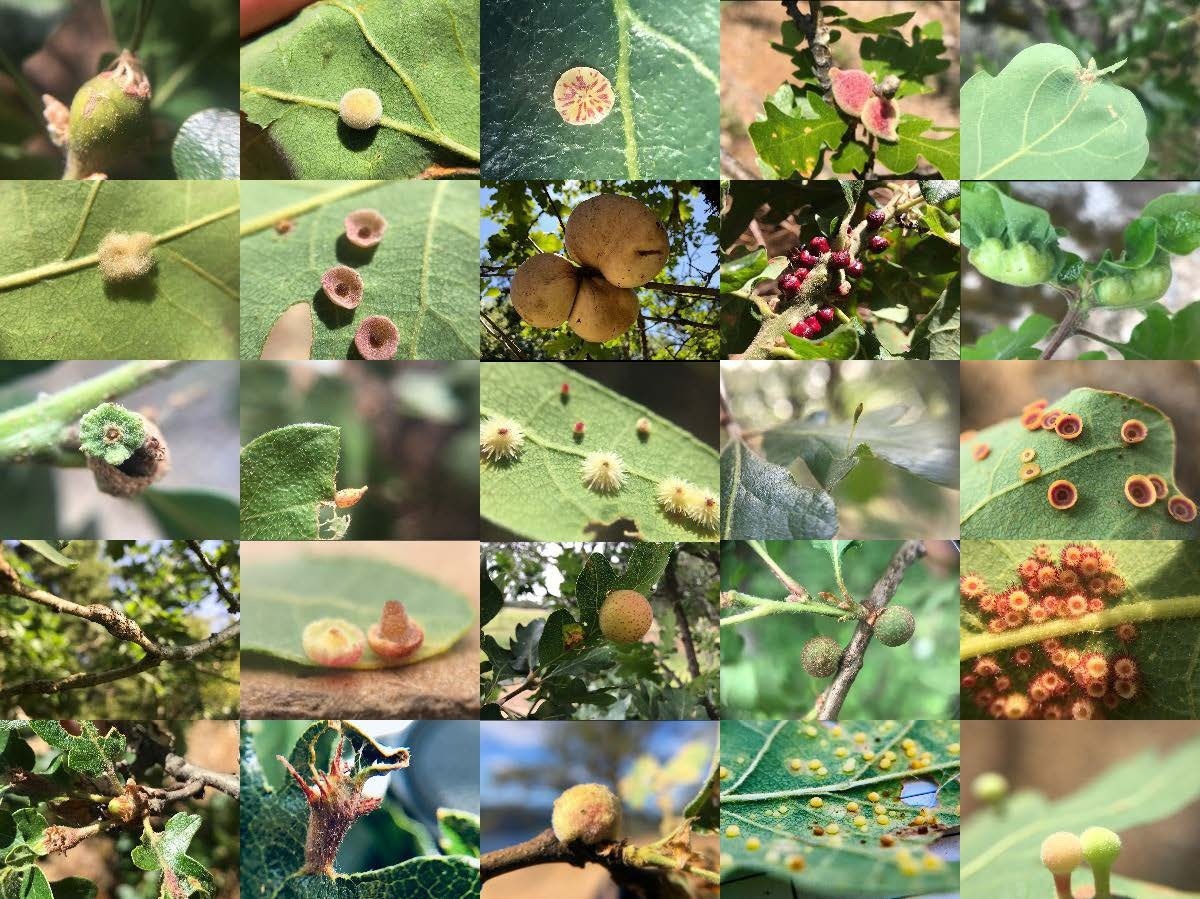According to new research from Binghamton University, rising temperatures in the Pacific Northwest have caused some insect species to expand their range into more northern oak savannas.
 A collage of oak galls created by oak gall wasps. Image Credit: Provided photo.
A collage of oak galls created by oak gall wasps. Image Credit: Provided photo.
Dylan Jones placed two images of oak leaves from the West Coast’s oak savannas side by side.
One, a structure created by an herbivorous species of oak gall wasp, is healthy and green with the occasional gall. The second leaf, which had been harmed by an insect population without predatory checks and balances, was yellowed and frayed. Temperatures in the Pacific Northwest have increased due to climate change, and as a result, species like Neurotereus saltatorius have expanded their range into more northern oak savannas.
In the native range, you might find a handful of galls on a single leaf. In the expanded range, sometimes you’re finding thousands on a single tree. This is pretty prevalent throughout Vancouver Island.
Kirsten Prior, Assistant Professor, Biological Sciences, Binghamton University
Jones, a Doctoral candidate in biological sciences at Binghamton University and Clifford D. Clark Diversity Fellow, is the lead author of the study. Co-authors include Prior, field technician Julia Kobelt, then-undergraduate Jenna Ross and Assistant Professor of Biological Sciences Thomas Powell.
The research was published in the Journal of Animal Ecology.
The team visited 18 oak savannas between northern California and Vancouver Island in British Columbia to collect samples for the project, for which Prior secured funding from the National Geographic Society and the National Science Foundation in the summer of 2019. Numerous landowners, from private landowners to the Nature Conservancy, had to work together extensively on the project.
Oaks are the predominant tree species in grassy, shrubby environments called oak savannas. Quercus garryana, the species of oak in question, needs a dry environment. As a result, Prior explained, oak savannas are frequently found in the rain shadow of the West Coast’s mountain range.
Oaks are a diverse and significant group of trees in North America’s ecosystems, and they are home to a broad variety of insect species, including oak gall wasps. The galls that these wasp species produce can be stunning in their variety of shapes, from those that resemble enormous apples to others with multicolored spikes that resemble sea urchins.
It is interesting to note that Alfred Kinsey first focused on oak gall wasps before changing his focus to human sexuality.
There has been a long fascination by biologists and amateurs for this group of species because they’re pretty charismatic. You can go to an oak and see all these structures on it.
Kirsten Prior, Assistant Professor, Biological Sciences, Binghamton University
The parasitoid wasps, one of the most diverse and ecologically significant groups in the animal kingdom, are hosted by these galls in addition to their herbivorous creators. The latter is essential because they play a role in controlling insect pests. After hatching, parasitoid wasp larvae consume the oak gall wasp larvae. Parasitoid wasps then lay their eggs in the gall.
Although there is a great diversity of oak gall wasps in North America, little is known about their evolutionary relationships or even the precise identification of some species. Jones and Prior are a part of a group of scientists from around the continent who are working to change that.
Prior adds, “It’s important to continue to document biodiversity. We still haven’t described a good portion of the biodiversity on Earth, particularly with insects.”
Ecosystem Invaders
Over the course of that summer, the researchers visited their study sites three times. Some were situated on Bureau of Land Management property or on preserves connected to Indigenous villages. Others required drives down dirt logging roads and were fairly remote. Others were suburban, just outside of cities.
On Vancouver Island, there are not many oak savannas left because of urbanization, but the ones that are there are well-documented and cared for by landowners.
We’ve had long relationships with lots of landowners there that allow us to work on their property. Some of them are so jazzed to have researchers there.
Kirsten Prior, Assistant Professor, Biological Sciences, Binghamton University
In advance of the parasitoid species that often prey on them, warming temperatures allowed Neurotereus saltatorius to extend its range into higher latitudes and altitudes than before, according to Jones. The Canadian Forest Service was the first to monitor the oak gall wasp’s increased range on Vancouver Island and its effects on a rapidly disappearing ecology in the 1980s.
According to Jones, biodiversity typically follows a latitudinal gradient: The closer you are to the equator, the more species you have. Higher altitudes present a condition that is comparable. When a species can expand its range due to rising temperatures, it can enter places where there are a few different predators and rivals, eventually overrunning the ecosystem.
The researchers note that the case of the oak gall wasps emphasizes the significance of biodiversity and the potential long-term effects of climate change.
Jones concludes, “Biodiversity can be really important in potentially protecting areas from invading species. If we have strong competitors and predators, this might make areas less susceptible to invading species.”
Journal Reference:
Jones, D. G., et al. (2022) Latitudinal gradient in species diversity provides high niche opportunities for a range-expanding phytophagous insect. Journal of Animal Ecology. doi.org/10.1111/1365-2656.13780.